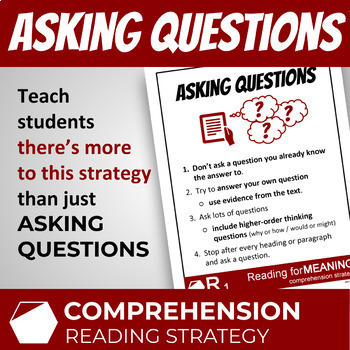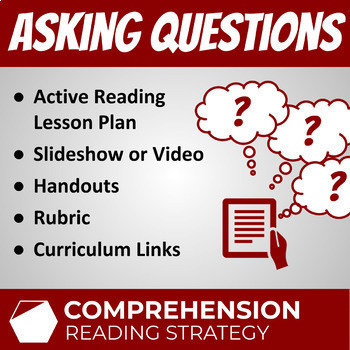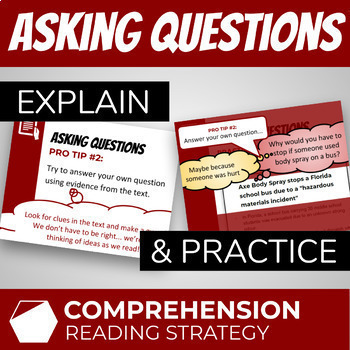Asking Questions Reading Comprehension Lesson Distance Learning Google Classroom
- Google Drive™ folder

Description
Asking questions is more than simply asking questions while you read.
Use this video or slideshow lesson to help students engage more deeply when they are doing Active Reading.
Students use the independent work package handouts to demonstrate their thinking as they read.
The slideshow lesson is comprehensive, easy to use and includes everything you need whether you are:
- DISTANCE LEARNING in Google Classroom
- or FACE to FACE LEARNING in your real classroom
IMPORTANT APRIL 21, 2022 UPDATE!
- Please don't buy this version: It is an older Google Drive™ resource. I will be deactivating this resource in the future. (If you've already purchased it, don't worry. You will still have access to all of the Google Drive files.)
- Instead, please buy the newer digital download product, which includes the EASEL by TpT digital learning version.
- The newer version is on SALE for a limited time (as I convert my resources to this digital download format.)
- If you purchased this older Google Drive™ resource in the past, please read this post about how to get the newer digital download product.
In this package, you get...
✅ the slideshow lesson to walk your students through
- 4 tips to use the asking questions strategy
- an example of how to use this strategy
- how this strategy connects with active reading and 21st century learning skills.
✅ a generic asking question handout package
- that can be used with any text.
- helps students ask questions before, during, and after reading.
✅ a metacognition handout with reflection questions
- to help students reflect on this strategy
- to encourage a growth mindset while reading
✅ a rubric to assess or evaluate
- ideas generated during reading, as well as
- ideas generated during the metacognition reflection.
▶️ BONUS VIDEO:
- I’ve recorded the slideshow as a FREE YOUTUBE VIDEO so it’s easier to teach with DISTANCE LEARNING: https://youtu.be/I_4AreWn2_Q
IMPORTANT NOTE: This product DOES NOT include a text for students to read! The package only includes the Asking Questions strategy slideshow lesson and handouts.
It is intended for teachers to use with a novel or text that they are studying in class.
Reading comprehension strategies like asking questions help students engage with the text and gain a deeper understanding than just passively reading.
If you want this product with reading texts, please check out our Asking Questions bundle.
✅ Asking Questions Reading Comprehension Bundle
- Asking Questions Reading Comprehension Strategy Lesson (This lesson)
- Article 001: Axe Body Spray stops a School Bus (Critical Thinking)
- Article 002: Business Owner Pays it Forward (Citizenship)
- Article 003: Pork Roast Cooked in Car (Creativity)
- Article 004: Airplane Wheel Falls Off (Character)
- Article 005: Rosa Parks - Quiet Courage (Assertive Communication)
✅ OTHER Reading Comprehension Strategies:
SAVE TIME and MONEY by getting the Reading Comprehension Strategies MEGA Bundle
- Asking Questions (This lesson)
- Making Connections
- Inferring
- Repairing Comprehension
- Evaluating
- Finding the Main Idea
This lesson is linked to the Common Core State Standards (CCSS) as well as the Province of Ontario Language Arts Curriculum.
The preview file shows you screenshot and thumbnail previews of exactly what you get in this product.
✅ DISTANCE LEARNING with GOOGLE CLASSROOM
- Create an assignment in your Google Classroom
- Explain what students will be reading - either a novel or textbook that you are using in class or one of our 21st Century Articles (not included.)
- Attach a link to the YouTube video https://youtu.be/I_4AreWn2_Q
or Attach the Google Slides lesson. - Create a copy of the Google Docs Independent Work Package handouts for each student to record their thinking.
✅ NO PREP VERSION for FACE to FACE learning in your real classroom
- Watch the lesson video here: https://youtu.be/I_4AreWn2_Q
- Print the PDF handouts
- Use the independent work handouts with a novel or textbook that you are using in class or one of our 21st Century Articles (not included.)
✅ EDIT and MODIFY the files for FACE to FACE learning in your real classroom
- Update the Google Slides or Google Docs to fit your class needs
- Teach the slideshow lesson to your class, getting students to participate and give answers during the lesson
- Print the handouts and use with a novel or textbook that you are using in class.
If you have any questions, please don't hesitate to ask below in the Question & Answer section or email me at Mike@educircles.org
CHANGE LOG
Version 1.6 (Aug 13, 2021)
NO MAJOR CHANGES made to content (slideshow, lesson plan or handouts.)
- Fixed sentence error in Metacognition handout (File 4b)
Other changes
- Read Me File now includes updated copyright / credits page (v2021-08-13); simplified section on what you get.
- Added © copyright symbol to Educircles footer as a reminder
- Removed Educircles from file names to make them shorter
Version 1.5 (Jan 21, 2020)
- Updated this product to get ready for Distance Learning and Google Classroom
- Updated the read me first PDF
- This product is now available as a bundle with 5 reading comprehension articles
(each written at 3 different reading levels.) - NO CHANGES made to content (slideshow, lesson plan or handouts.)





